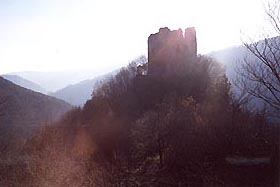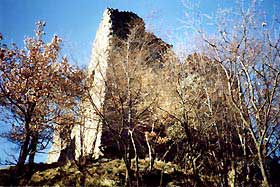Rocca Cerbaia
 |
 |
| The fortress, crowning a hill in the valley of the river Bisenzio. | The ruins of the keep, on the highest point of the rocky hill. |
The Fortress of Cerbaia not easily reachable only by foot through a path in the wood, the nr.48 of the CAI-Prato, from the country of Carmignanello which can be reach from Prato following SS.325 toward Vaiano/Vernio.
Click here for more Photos - Take a look at some Old Images of this castle or at its Medieval Bridge.
The Rocca of Cerbaia, also named only Rocca Cerbaia, dominates the peak of a rocky spur four hundred meters high overlooking the valley of the river Bisenzio. Its origin seems to go back to the beginnings of the 12th century, when the Count Alberti erected on the site a small fortress at control of the ancient road of 'Lombardy', main connection between Tuscany and the northern regions of Italy. Despite its predominantly military functions, the fortress was also for a long period used by the Alberti family as their usual residence, and this is confirmed from the touch of good manufacture still visible inside the keep. The legend, surely deprived of foundation, says that in 1285 the Alberti refused the request of political asylum of the great Poet Dante Alighieri, exiliated from Florence. The same Poet made famous one of the descending daughters of the family, Cunizza Alberti, protagonist of an animate sentimental life in the 'Divine Comedy' (Heaven IX, 13-36).
In 1361 the fortress was sold to the Florentine that, due to its important strategic position, garrisoned permanently the stronghold and reinforced its defenses. Rocca Cerbaia has the classical aspect of the italian medieval castle-fence: a mighty Keep dominates from the center two circuits of walled enclosures approximately of square form. The construction, performed in sandstone of which the zone is rich, lies our days in serious conditions of degrade. Nevertheless vast portions of the first wall circuit still remains, with the Main Gate inserted on the south side; just crossed the gate we find on the left the rests of the Chapel of the complex. Between the ruins of the second ward we can notice the cistern, with a barrel coverage, and some other buildings. In the core of the fortification rises the Keep with its central tower, once highest than today, with functions of look-out and are still visibles the breaches of the windows and a piscina on the eastern wall. This was the residence of the castle constable. It seems that this part of the complex has been reconstructed toward the half the 13th century, taking as model the Castello dell'Imperatore (Emperor's Castle) of the near city of Prato. Is not possible to affirm with certainty that this corresponds to truth, due to the actual disastrous condition of the Rocca. Some parts of the ruins, in particular those from the side of the precipice, are yet to serious risk of definitive collapse.
Recently the castle has been bought by the commune of Cantagallo, with the support of the province of Prato, for 60 million of Lire and the community is planning the works of restoration and valorization of Rocca Cerbaia.
| More Photos |
| Back to Homepage |
| Back to Castles Index |